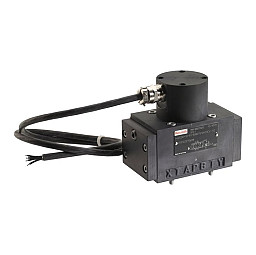Бренды
Directional servo-valves in 4-way variant 4WS.2E...
Directional servo-valves in 4-way variant 4WS.2E...
-
Size 10
-
Component series 5X
-
Maximum operating pressure 315 bar
-
Maximum flow 180 l/min
- Valve to control position, force, pressure or velocity
- 2-stage servo valve with mechanical or mechanical and electrical feedback
- 1st stage nozzle/flapper plate amplifier
- For subplate mounting: Porting pattern according to ISO 4401
- Dry control motor, no contamination of the solenoid gaps by the hydraulic fluid
- Can also be used as 3-way version
- Wear-free control spool return element
- Control external or with integrated electronics (OBE)
- Valve and integrated control electronics are adjusted and tested
- Control spool with flow force compensation
- Control sleeve centrically fixed, thus low susceptibility to temperature and pressure
- Pressure chambers at the control sleeve with gap seal, no wear of seal ring
- Filter for 1st stage freely accessible from the outside
|
Type |
4WSE2ED | 4WS(E)2EM | ||
|
Nenngröße |
10 | |||
|
Geräteserie |
5X | |||
|
Einbaulage |
Any - if it is ensured that during start-up of the system, the valve is supplied with sufficient pressure (≥10 bar)! | |||
|
Storage temperature range |
°C |
-20 … +80 | ||
|
Masse |
kg |
3.65 | 3.56 | |
|
Ambient temperature range |
with OBE |
°C |
-20 … +60 | |
|
without OBE |
°C |
30 … 100 | ||
4WS(E)2EM10-5X/...
Valves of type 4WS(E)2EM10-5X are electrically operated, 2-stage directional servo valves. They are mainly used to control position, force and velocity.
These valves are made of an electro-mechanical converter (torque motor) (1), a hydraulic amplifier (principle: nozzle flapper plate) (2) and a control spool (3) in a sleeve (2nd stage) which is connected with the torque motor via a mechanical feedback.
An electrical input signal at the coils (4) of the torque motor generates a force by means of a permanent magnet which acts on the armature (5), and in connection with a torque tube (6) results in a torque. This causes the flapper plate (7) which is connected to the torque tube (6) via a bolt to move from the central position between the two control nozzles (8), and a pressure differential is created across the front sides of the control spool. This pressure differential results in the control spool changing its position, which results in the pressure port being connected to one actuator port and, at the same time, the other actuator port being connected to the return flow port.
The control spool is connected to the flapper plate or the torque motor by means of a bending spring (mechanical feedback) (9). The position of the control spool is changed until the feedback torque across the bending spring and the electro-magnetic torque of the torque motor are balanced and the pressure differential at the nozzle flapper plate system becomes zero.
The stroke of the control spool and consequently the flow of the servo valve are controlled proportional to the electrical input signal. It must be noted that the flow depends on the valve pressure drop.
External control electronics, type 4WS2EM10-5X/... (separate order)
External control electronics (servo amplifier) serve the actuation of the valve, amplifying an analog input signal (command value) so that with the output signal, the servo valve is actuated in a flow-controlled form.
Integrated control electronics, type 4WSE2EM10-5X/... and 4WSE2ED10-5X/...
For amplification of the analog input signal, special control electronics (10) adjusted to this valve type have been integrated. They are attached to the cover cap of the torque motor. The valve zero point can be adjusted by means of an externally accessible potentiometer.
4WSE2ED10-5X/...
For the mechanical control by the return spring, valves of this type are additionally equipped with electric spool position detection and control. The control spool position is determined by means of an inductive position transducer (11). The position transducer signal is compared to the command value by the integrated control electronics (10). Any possible control deviation is amplified electrically and fed to the torque motor as control signal. With the additional electric feedback, higher dynamic values are achieved than with the purely mechanical variant due to the electric controller amplification in the small signal range. The mechanical feedback which is also available makes sure that in case the electric voltage supply fails, the valve spool is positioned in the zero range.
The valve is only available with integrated control electronics. The valve zero point can be adjusted by means of an externally accessible potentiometer.
Notice:
Changes in the zero point may result in damage to the system and may only be implemented by instructed specialists.
Type 4WS2EM 10...


















